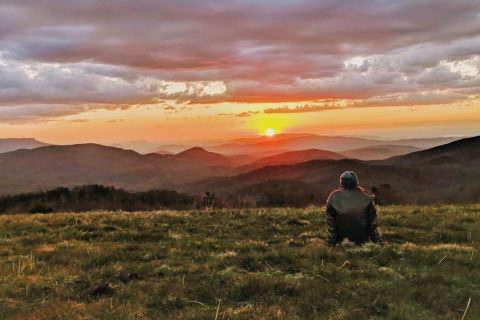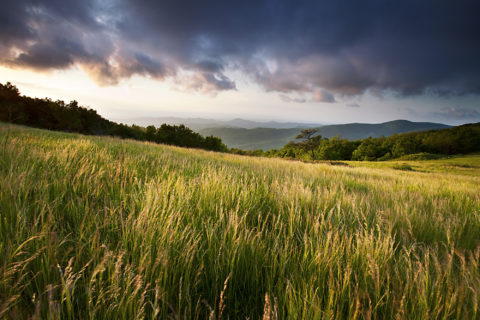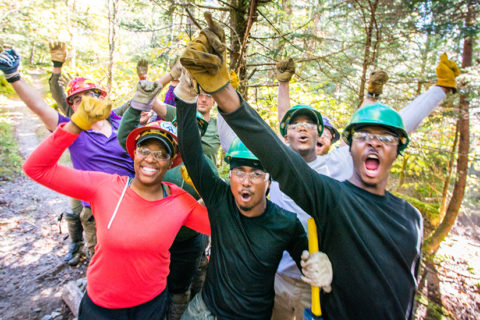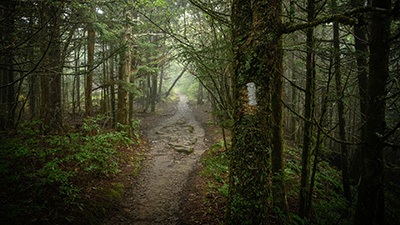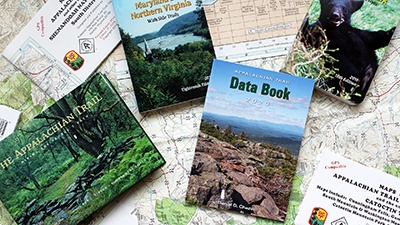Learn More
Hiking Games & Activities
Hiking Games & Activities
The following “Hip Pocket Activities,” developed by Delia Clark and Pat Straughan for Shelburne Farms, can be done any time, any place, and in any order. Choose a few favorites and keep the simple low-cost supplies ready in your pack for an opportune moment. Most of the activities will take about 5 to 10minutes, but a few require extra time, as noted.
These activities are a wonderful way to begin a hike, to keep a group together, to spice up a destination, or to occupy part of the group while the other part catches up or engages in a different activity. Adults will enjoy them as much as children!
ACTIVITY BOOK
Appalachian Trail Adventure Book:
Materials: Pencil, pen, crayons, markers, printed copy of the activity book
Click to download a copy of the Adventure Book (rev2016). Print out a copy and enjoy!
HIP POCKET ACTIVITIES
Sharp Eyes:
Materials: none
Stand opposite your partner. Take a close look at what each of you is wearing. Be sure not to miss any details. Look so closely that if anything were to change you would notice it! Then, turn away from each other and each change ONE thing about your dress (roll up a cuff, move a ring, undo a shoelace, etc). Now, turn back, and your partner has to find out what has changed. If they can’t, give them a clue. When you feel your detective skills are honed, set off to explore the natural world.
A Fistful of Sounds:
Materials: none
Gather the group in a circle. Explain that you will all be silent for a minute and you will each be keeping track of all the different sounds you hear on your fingers.Have everyone hold up both hands and close their eyes. Announce when a minute starts and ends. Have everyone open their eyes with their hands still in the air and look around at everyone else’s fingers. Ask people to name some of the different sounds they heard.
Color Search:
Materials: small color paint chips from hardware store, either a great variety of colors OR many different shades of green or brown OR small cards colored with crayons
Ask your group to look around: what colors do they see most of around them? Expect brown and green to predominate. Challenge them to look more closely for other colors by handing out color chips. Use a variety of unusual colors and challenge them to find the closest match they can by looking under things, up, down, up close. They should not pick living things, but rather just share it with another person – you should circulate to inspect everyone’s discoveries. Some will pick up bits of bark etc, so you might gather everyone in a circle to see these. Using a variety of bright colors will bring surprising finds in the habitat, but using many shades of green, for example, will highlight small differences between grasses, leaves and mosses. After the activity, discuss their findings. Were they surprised by the colors they found or the number of variations of a single color?
Shape Search:
Materials: small pieces of card cut into squares, circles, oblongs and “squiggles,” etc.
Take a new look at your surroundings by trying to see them as a collection of shapes. Take one card at a time and try to find the shape in the plants, buildings, water or animal tracks in your place.
Texture Match or Wake up Fingers:
Materials: brown bags, each containinga household object with a distinctive texture – sandpaper, crumpled aluminum foil, plastic bags, packing bubbles, etc.
To get a feel for your place, lay the bags along a trail or in a circle and challenge folks to use their fingers ONLY to investigate the texture in the bag WITHOUT LOOKING at the contents. Ask them to give a good word to describe the feel of the object. They can then take their fingers and touch things in the habitat until they find the best match. Share. Compare several textures.
Nice-Smell Social:
Materials: tiny tasting cup or other “sundae” container for each person
Take a deep breath in your habitat. Can you detect any special aroma in this place?
What if you were to take a closer smell around you? Challenge each member of the group to think of this as an ice cream social, but instead of composing a sundae out of their favorite ice cream and toppings, they will create a “sundae” of the best smells they can find in the place. When sundaes are complete, have a social! Take a relaxing tour around all the members of the groups and find out what their aromatic ingredients are.
Mirror Magic:
Materials: a hand mirror for each participant
Take a mirror out to your special place. Sit down and look at your surroundings reflected in your mirror. They will be upside down, so talk about a fresh look! Can you see anything about the trees, for example, that you had not noticed before? Pick an object of interest, such as a branch on a tree, and try to describe where it is to a friend looking through their own mirror. See if you can give good enough spatial directions so that they can find it.
Mystery Collection:
Materials: One egg carton per group, with two words written on bottom (one word on left, one on right)
Ask the pair or group to look at their words written on the bottom of the egg carton. Keep the words secret from other groups! The challenge is to fill six spaces in the carton with items that fit one descriptive word, and fill the other half of the carton with items fitting the other word. When the collection is as good as it can be, take it to another group and challenge them to figure out what the hidden words might be! Or you can gather all the groups in a circle and the group can work together to guess the words on one carton after another. Sample words: round, square, curly, straight, prickley, tickley, white, black, green, brown, soft, hard, whole, holey, smooth, rough. This activity takes about 20 minutes, depending on group size.
Poesy Poetry:
Materials: three trees/flowers/pigs/ecosystems and three envelopes each containing several small pieces of paper and one big one, and several pencils
Let’s just take trees as the example. Here’s a wonderful way to take a closer look at the differences between, and essential characteristics of, three trees. Select the trees you will use by laying an envelope next to each one. (To make the challenge easier, chose three very different trees, such as a sapling, a mature tree, and a rotting stump! Pile the pencils and small papers outside the envelope.
Each person in the group should visit each of the three trees, wandering around in any order, taking as long as they need. They should spend a little time contemplating the tree, choose a word or short phrase that they feel captures the spirit or feel of the tree, write it on a small paper and put it in the envelope. Their word or phrase should not say the name of the tree, such as “White Pine”, but rather capture it’s essence, such as “King of the forest!” Each person does this for each tree. When all are finished describing, gather the envelopes and bring the group together. Divide them into three groups and give each group an envelope. Challenge them to create a poem from the words inside the envelope.
Rules: Participants may NOT omit any words (if there are four “tall” words, they must include them all. They CAN add extra words if they wish, but just simple connecting words.
When the group has compiled their poem, they should copy it onto the larger piece of paper and figure out a way to do a dramatic theatrical reading of their poem for the other two groups. Which poem described which tree? Congratulate the group on their marvelous descriptions and productive team work. This activity takes about 30 to 45 minutes.
Place Poem:
Materials: one piece of paper and pencil
With younger children, one can use a similar technique to capture the essence of a place – useful when we can’t take this place back to the classroom with us to share!! Gather the group in a circle or on a log. Ask them to look around this place and think of one word that describes it for them. Silently! Walk down the line and have each person WHISPER their word to you as you record them on a paper. Simply read back the list with a “poetic” voice, and you have all created a wonderful poem that can transport any reader to this place.
Focus Rings:
Materials: toilet paper tubes or tube shapes rolled from playing cards or squares of cardboard, one per person
Distribute the focus rings. Challenge each person to find something in the forest, meadow (or wherever you are) that they have never noticed before. Demonstrate walking right up to within an inch of a tree trunk, lying on the ground face down, looking straight up, etc to give them the idea of varying their perspective. Wander among the group, asking them to show you what they noticed. You can also pair them up at the start and have them show their partner what they found.
Silent Activity:
Materials: none, or a journal, or a piece of paper clipped to cardboard and pencil
Have each person find a quiet place to sit alone. Depending on the age, you might want to say that they need to be able to see you, or shouldn’t go past that big tree, or whatever. Different ways you can have them use this time include:
- Simply sitting alone and quiet – a rare event for many – keep it fairly short.
- Have them create a sound map – try to develop a visual representation or key for different kinds of sounds and record their hearings on a paper, with themselves marked in the center as an X
- If age-appropriate, have them journal about a particular question, such as “What is one thing you can see here that fascinates you. What does it make you think of in your own life?” or “What would it be like if you were sitting here in the middle of winter (or summer if it is winter!)?
Make sure to share and debrief what they heard.
Jenny’s Game:
Materials: one leaf/ pine cone/ acorn for each person – choose an appropriate item, but make them all similar – i.e. all maple leaves
Gather in a circle. Give a leaf to each person. Ask them to take a couple minutes to get to know this leaf SO well that if they were to lose it they could recognize it again. Gather all leaves. Begin to pass the leaves, one at a time, to your right. Give the following instructions:
“If its YOUR leaf, hold onto it. If its not, pass it on”. When all have been reunited, share some of the characteristics they used for identification. How did they feel when they found their friend again??!!
Drawing Swap:
Materials: small clipboards and paper and pencils
Have the group line up along a stretch of trail, or in a circle, facing out, and sit down. Ask each person to pick ONE detail of a tree, plant, geologic formation, etc that they find particularly interesting. They then draw that detail, not the whole scene. When they are satisfied that they have captured the distinctive quality, have them switch drawings with a friend, or collect them all and distribute them. The task is to try to find the detail that was drawn by the other person.
Belly Botany or Lie Down and Look:
Materials: Circle of string; paper and pencil
use a string to make a circle on the ground. Lie down and look. Draw a circle on your paper. Map everything you can find within the circle. Share. What did you find that surprised you? Take an ants’ eye view of life in this small plot.
Animal Camouflage:
Materials: none
Find out what its like to be an animal in this place! You can start by being “it” in the middle. Close your eyes and count to “15” or “20”. While your eyes are closed, the children should hide themselves. Open your eyes and call out the names of anyone that you can see without moving from your spot. The ones you can see are out and should come to the middle with you. Close your eyes and count again. The children should move in and camouflage themselves again. Repeat a couple of times. Whoever is the closest person to the “it” at the end of the last round and is still camouflaged is the winner! If you do not feel comfortable enough with your group to be “it” with your eyes closed, have one of the children be “it” and help them. Don’t forget to tie this in with animals need to escape their predators, and to discuss which camouflage strategies work best.
Art Gallery:
Materials: cardboard frames, one for each pair
Gather the group in your place. Have the participants take a partner. Give a cardboard frame to each pair. One person is the artist, the other will hold the frame for them. The artist can choose their favorite view within the place and position the frame exactly to capture that view. The frame holder must keep the work of art as it is, while other artists view the gallery and visit all the chosen works of art. Then switch roles within the partners. Discuss the natural elements which captured the notice of the artists.
Becoming One with This Place:
Materials: none
As you move through the place, leave one person at a time to be placed in the habitat….lying down and being covered slightly with sticks, ferns, leaves etc from the ground. Having the weight of forest floor debris over your body helps to ground you in this place. All lie still and silent until everyone is in position. Allow the group an appropriate time to spend simply being part of this place. Use a gentle symbol to end the activity. Gather and silently leave the place. Share thoughts a little ways off.
Last Picture:
Materials: none
This activity is similar to Art Gallery, but simpler. Before you leave a place, have the group imagine that they have one picture left in their camera. The “camera” is made by framing pointer fingers and thumbs into a square and looking through it. Which “shot” would each person choose for their last picture. Share. Remember this place.

